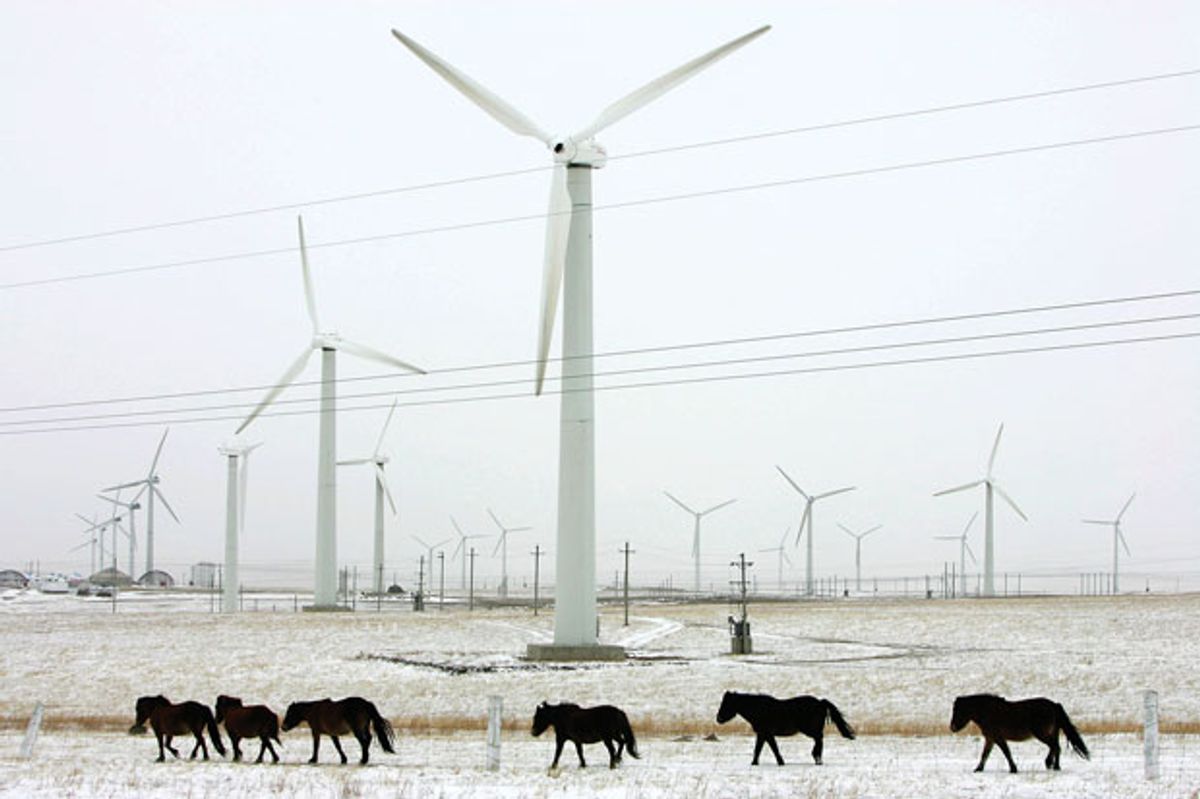The 16th of October marks the start of heating season in northern China. Traditionally that means firing up coal boilers and pumping excess heat from big coal-fired electric plants to residences and businesses. This year, another heat source will join the mix: wind power. District heating systems across northern China are preparing to use small injections of heat from electric boilers that will be soaking up power generated from the region’s robust overnight winter winds.
Wind-to-heat demonstration projects, including installations in Hebei, Inner Mongolia, Liaoning, and Xinjiang, will offset only a little coal. But their real raison d’être is to demonstrate a strategic sink for northern China’s massive wind farms, whose output is increasingly being crowded out of the electric power market by coal-fired turbines and has nowhere else to go.
China’s selective shutdowns of wind power hit record levels last year, and the country is likely to smash those records in 2016. Curtailment of wind farms squandered 15 percent of China’s wind energy potential in 2015, and those losses surged to 21 percent during the first half of 2016, according to China’s National Energy Administration (NEA). Solar farms also face rising curtailment; 10 percent of their output went unused last year.
Experts say wind-to-heat and other technical solutions are ready to reverse China’s curtailment trend, but Beijing and regional governments have yet to implement the policy changes required to support them—policies that would significantly hurt coal-fired generators. “Curtailment has not been solved yet,” says Ranping Song, a China energy expert with the World Resources Institute (WRI), in Washington, D.C.
Leaders in Beijing have committed to cap coal consumption and promote renewable energy as a way to clean up smog-choked cities and cut carbon emissions. They have vowed to push nonfossil sources up from today’s 12 percent share of China’s energy mix to 15 percent by 2020. Song says that in order to meet those goals, China must continue installing wind and solar power at its world-leading pace and “make sure that generation from the installed capacity gets consumed.”
But here’s the rub: Construction of coal-fired power plants continues, expanding King Coal’s capacity by 7.8 percent last year. As the growth of China’s power demand slows—edging up just 0.5 percent last year—generators must jockey for access to the power grid.
The tussle is especially fierce across northern China, where the nation’s biggest wind farms butt heads with combined heat-and-power (CHP) plants, which deliver roughly two-fifths of the region’s space heating. The coal-fired CHP plants must run in the winter, just when northern winds are blowing strongest. Curtailment in Inner Mongolia—China’s leading wind power region—doubled to 18 percent in 2015 and leapt to 30 percent through June 2016.
Some relief is en route from ultrahigh-voltage transmission projects that are designed to export northern power to pollution-choked eastern cities. However, it remains to be seen how quickly demand for the power delivered by the lines will materialize, especially for the wind power, which peaks at night. The Lantau Group, a Hong Kong–based consultancy tracking China’s transmission program, concluded recently that renewables curtailment “probably will get worse before getting better.”
A more certain curtailment remedy is the electric boiler, according to Ning Zhang, a power systems expert at Beijing’s Tsinghua University. In 2015, Zhang and colleagues studied Inner Mongolia’s western grid, where the territorial government anticipates a doubling of wind power capacity in the next five years. They projected that electric boilers drawing surplus wind power would be an economic slam dunk.
Zhang determined that electric boilers drawing 6.19 gigawatts could provide 30 percent of the projected 2020 heat demand; that would offset enough coal consumption to save consumers US $5.2 billion over the boilers’ operating lives. That is a large payback on the equipment’s $1.4 billion installation cost. Additional health and productivity benefits would accrue from reductions in air pollution.

But the electric boiler projects moving forward so far are modest demonstrations: megawatt-scale projects propelled by subsidies and one-off deals between heating plants and wind generators. Such is the case for a district heating expansion that recently broke ground in Hohhot, Inner Mongolia’s capital. It will ultimately use two 25-megawatt boilers running on overnight wind power to provide a fraction of its 1,422-MW heat supply.
The hang-up to gigawatt-scale implementation, says Zhang, is inflexible power pricing and cheap coal. For most wind-heavy power grids, such as those in Texas and Denmark, markets adjust prices hourly based on supply and demand, making abundant overnight wind power available at low prices. But according to Zhang, China’s heating plants must purchase overnight wind power at a fixed retail price, making the switch from coal to wind power costly.
And China’s grid controllers add other impediments to fixing curtailment, says Zhang. Grid operators set generation and transmission schedules up to one month in advance, and they program coal power plants to operate continuously for a week or longer. This limits their ability to accommodate hourly or daily fluctuations in renewable output. Flexibility is further limited by utilization quotas that guarantee coal plants a certain number of operating hours per year.
In Beijing, China’s leaders are still talking change. A year ago, President Xi Jinping promised a “green dispatch” policy that would give renewables priority grid access. China’s NEA, meanwhile, has recently drafted several power market reforms that would, for example, eliminate the utilization quotas. There is also ongoing discussion about shifting to market-based power pricing via competitive bidding.
Real change may be years in the making, however. And meanwhile, political pressure from coal interests is assured. “There’s still turbulence in China’s transition to clean energy,” says Song at WRI. “While the journey has clearly started, it is far from a done deal.”
